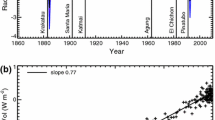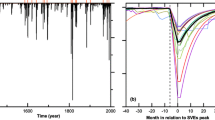Abstract
Volcanic ‘super-eruptions’ have been suggested to have significantly influenced the Earth’s climate, perhaps causing glaciations and impacting on the human population. Climatic changes following a hypothetical ‘super-eruption’ are simulated using a coupled atmosphere ocean general circulation model, incorporating scaled volcanic stratospheric aerosols. Assumptions are made about the stratospheric sulphate aerosol loading, size distribution, lifetime, chemical make up and spatial distribution. As this study is concentrating on the physical climatological impacts over long timescales, microphysics and chemical interactive processes are not simulated. Near-surface temperatures fall by as much as 10 K globally for a few months and a considerable deviation from normal temperatures continues for several decades. A warming pattern is evident over northern land masses during the winter due to increased longwave forcing and a positive AO mode. The overturning rate of the North Atlantic thermohaline circulation doubles in intensity. Snow and ice increases in extent to a maximum coverage of 35% of the Earth. Despite these and other impacts longer term climatic changes that could lead to a transition to a glaciation do not occur, for present day boundary conditions and one possible plausible aerosol loading.












Similar content being viewed by others
References
Allen MR, Ingram WJ (2002) Constraints on future changes in climate and the hydrological cycle. Nature 419:224–232
Ambrose S (1998) Late pleistocene human population bottlenecks, volcanic winter, and differentiation of modern humans. J Hum Evol 34:623–651
Ambrose SH (2003) Did the super-eruption of Toba cause a human population bottleneck? reply to Gathorne-Hardy and Harcourt-smith. J Hum Evol 45:231–237
Bekki S (1995) Oxidation of volcanic SO2: a sink for stratospheric OH and H2O. Geophys Res Lett 22:913–916
Bekki S, Pyle JA, Zhong W, Toumi R, Haigh JD, Pyle DM (1996) The role of microphysical and chemical processes in prolonging the climate forcing of the Toba eruption. Geophys Res Lett 23:2669–2672
Church JA, Gregory JM, Huybrechts P, Kuhn M, Lambeck K, Nhuan MT, Qin D, Woodworth PL (2001) Changes in sea level. In: Houghton JT et al (eds) Climate change 2001: the scientific basis. Contribution of Working Group I to the Third Assessment Report of the Intergovernmental Panel on Climate Change. Cambridge University Press, pp 639–693
Collins M (2004) Predictions of climate following volcanic eruptions. In: Robock A, Oppenheimer C (eds) Volcanism and the Earth’s atmosphere, Geophys Monogr Ser, AGU, pp 283–300
Covey C, Thompson SL, Weissman PR, MacCracken MC (1994) Global climatic effects of atmospheric dust from an asteroid or comet impact on Earth. Global Planet Change 9:263–273
Cubasch U, Meehl GA, Boer GJ, Stouffer RJ, Dix M, Noda A, Senior CA, Raper S, Yap KS (2001) Projections of future climate change. In Houghton JT et al (eds) Climate change 2001: the scientific basis. Contribution of Working Group I to the Third Assessment Report of the Intergovernmental Panel on Climate Change. Cambridge University Press, pp 525–582
Forster PM de F, Collins M (2003) Quantifying the water vapour feedback associated with post-Pinatubo global cooling. Clim Dyn 23:207–214. DOI:10.1007/s00382-004-0431-z
Gathorne-Hardy FJ, Harcourt-Smith WEH (2003) The super-eruption of Toba, did it cause a human bottleneck? J Hum Evol 45:227–230
Gordon C, Cooper C, Senior CA, Banks H, Gregory JM, Johns TC, Mitchell JFB, Wood RA (2000) The simulation of SST, sea ice extents and ocean heat transports in a version of the Hadley Centre coupled model without flux adjustments. Clim Dyn 16:147–168
Gregory JM, Ingram WJ, Palmer MA, Jones GS, Stott PA, Thorpe RB, Lowe JA, Johns TC, Williams KD (2004) A new method for diagnosing radiative forcing and climate sensitivity. Geophys Res Lett 31(L03205). DOI:10.1029/2003gl018,747
Hewitt SD, Broccoli AJ, Mitchell JFB, Stouffer RJ (2001) A coupled model study of the last glacial maximum: was part of the North Atlantic relatively warm? Geophys Res Lett 27:1571–1574
Highwood EJ, Stevenson DS (2003) Atmospheric impact of the 1783–1784 Laki eruption: Part II—climatic effect of sulphate aerosol. Atmos Chem Phys 3:1177–1189
Huang C, Zhao M, Wang C, Wei G (2001) Cooling of the South China Sea by the Toba eruption and correlation with other climate proxies ∼71,000 years ago. Geophys Res Lett 28:3915–3918
Johns TC, Gregory JM, Ingram WJ, Johnson CE, Jones A, Lowe JA, Mitchell JFB, Roberts DL, Sexton DMH, Stevenson DS, Tett SFB, Woodage MJ (2003) Anthropogenic climate change for 1860 to 2100 simulated with the HadCM3 model under updated emissions scenarios. Clim Dyn 20:583–612. DOI 10.1007/s00382-002-0296-y
Jones GS, Tett SFB, Stott PA (2003) Causes of atmospheric temperature change 1960-2000: a combined attribution analysis. Geophys Res Lett 30:32–1, 32–4. DOI:10.1029/2002GL016377
Lang C, Leuenberger M, Schwander J, Johnson S (1999) 16°C rapid temperature variation in Central Greenland 70,000 years ago. Science 286:934–937
Lee MY, Chen CH, Wei KY, Lizuka Y, Carey S (2004) First Toba supereruption revival. Geology 32:61–64. DOI:10.1130/G19903.1
Luder T, Benz W, Stocker TF (2003) A model for long-term climatic effects of impacts. J Geophys Res 108:10–1, 10–17. DOI:10.1029/2002JE001894
Murphy JM, Sexton DMH, Barnett DN, Jones GS, Webb MJ, Collins M, Stainforth DA (2004) Quantification of modelling uncertainties in a large ensemble of climate change simulations. Nature 430:768–772
Oppenheimer C (2002) Limited global change due to the largest known Quaternary eruption, Toba ≈74 kyr bp? Quaternary Sci Rev 21:1593–1609
Pierazzo E, Hahmann AN, Sloan LC (2003) Chicxulub and climate: radiative perturbations of impact-produced S-bearing gases. Astrobiology 3:99–118
Pinto JP, Turco RP, Toon OB (1989) Self-limiting physical and chemical effects in volcanic eruption clouds. J Geophys Res 94:11165–11174
Pope KO, Baines KH, Ocampo AC, Ivanov BA (1997) Energy, volatile production, and climatic effects of the Chicxulub Cretaceous/Tertiary impact. J Geophys Res 102:21645–21664
Pope VD, Gallani ML, Rowntree PR, Stratton RA (2000) The impact of new physical parametrizations in the Hadley Centre climate model—HadAM3. Clim Dyn 16:123–146
Prueher L, Rea D (1998) Rapid onset of glacial conditions in the subarctic North Pacific region at 2.67 ma: clues to causality. Geology 26:1027–1030
Rampino MR (2002) Supereruptions as a threat to civilizations on Earth-like planets. Icarus 156:562–569
Rampino MR, Self S (1992) Volcanic winter and accelerated glaciation following the Toba super-eruption. Nature 359:50–52
Rampino M, Self S (1993a) Bottleneck in human-evolution and the Toba eruption. Science 262:1955–1955
Rampino MR, Self S (1993b) Climate-volcanism feedback and the Toba eruption of ∼74,000 years ago. Quaternary Res 40:269–280
Rind D, Peteet D, Kukla G (1989) Can Milankovitch orbital variations initiate the growth of ice sheets in a general circulation model. J Geophys Res 94:12851–12871
Robock A (2000) Volcanic eruptions and climate. Rev Geophys 38:191–219
Robock A (2002) Pinatubo eruption—the climatic aftermath. Science 295:1242–1244
Rose W, Chesner C (1990) Worldwide dispersal of ash and gases from Earth’s largest known eruption: Toba, Sumatra, 75 ka. Global Planet Change 89:269–275
Sato M, Hansen JE, McCormick MP, Pollack JB (1993) Stratospheric aerosol optical depths (1850–1990). J Geophys Res 98:22987–22994
Scaillet B, Clemente B, Evans BW, Pichavant M (1998) Redox control of sulfur degassing in silicic magmas. J Geophys Res 103:23937–23949
Stenchikov G, Robock A, Ramaswamy V, Schwarzkopf MD, Hamilton K, Ramachandran S (2002) Arctic oscillation response to the 1991 Mount Pinatubo eruption: effects of volcanic aerosols and ozone depletion. J Geophys Res 107:ACL 28–1, 28–16. DOI 10.1029/2002JD002090
Stott PA, Tett SFB, Jones GS, Allen MR, Mitchell JFB, Jenkins GJ (2000) External control of 20th century temperature by natural and anthropogenic forcing. Science 290:2133–2137
Stott PA, Jones GS, Mitchell JFB (2003) Do models underestimate the solar contribution to recent climate change? J Climate 16:4079–4093
Tett SFB, Jones GS, Stott PA, Hill DC, Mitchell JFB, Allen MR, Ingram WJ, Johns TC, Johnson CE, Jones A, Roberts DL, Sexton DMH, Woodage MJ (2002) Estimation of natural and anthropogenic contributions to 20th century temperature change. J Geophys Res 107:ACL 10–1, ACL 10–24. DOI 10.1029/2000JD000028
Thorpe RB, Gregory JM, Johns TC, Wood RA, Mitchell JFB (2001) Mechanisms determining the Atlantic thermohaline circulation response to greenhouse gas forcing in a non-flux-adjusted coupled climate model. J Climate 14:3102–3116
Toon OB, Zahnle K, Morrison D, Turco RP, Covey C (1997) Environmental perturbations caused by the impacts of asteroids and comets. Rev Geophys 35:41–78
Turco RP, Toon OB, Ackerman TP, Pollack JB, Sagan C (1983) Nuclear winter—global consequences of multiple nuclear-explosions. Science 222(4630):1283–1292
Turco RP, Toon OB, Ackerman TP, Pollack JB, Sagan C (1984) The climatic effects of nuclear-war. Sci Am 251:23–33
Vellinga M, Wood RA (2002) Global climatic impacts of a collapse of the Atlantic thermohaline circulation. Climatic Change 54:251–267
Zielinski G, Mayewski P, Meeker L, Whitlow S, Twickler M (1996) Potential atmospheric impact of the Toba mega-eruption ∼71,000 years ago. Geophys Res Lett 23:837–840
Acknowledgements
Financial support to carry out the simulation and fund the authors was provided by UK Department for Environment, Food and Rural Affairs contract PECD 7/12/37 with additional funding for SFBT from the UK Government Met. Research contract. Thanks are due the many people who worked on developing HadCM3 at the Hadley Centre and to William Ingram and Michel Crucifix for comments. We would also like to thank the reviewers for their helpful comments and suggestions.
Author information
Authors and Affiliations
Corresponding author
Rights and permissions
About this article
Cite this article
Jones, G.S., Gregory, J.M., Stott, P.A. et al. An AOGCM simulation of the climate response to a volcanic super-eruption. Clim Dyn 25, 725–738 (2005). https://doi.org/10.1007/s00382-005-0066-8
Received:
Accepted:
Published:
Issue Date:
DOI: https://doi.org/10.1007/s00382-005-0066-8




